 重要提示:
请勿将账号共享给其他人使用,违者账号将被封禁!
重要提示:
请勿将账号共享给其他人使用,违者账号将被封禁!
 题目内容
(请给出正确答案)
题目内容
(请给出正确答案)
(a) Explain the concept of TRUE and FAIR presentation. (4 marks)
(b) Explain the status of International Standards on Auditing. (2 marks)
(c) ISA 230 Audit Documentation deals with the auditor’s responsibility to prepare audit documentation for an audit of financial statements.
Required:
State FOUR benefits of documenting audit work. (4 marks)
 更多“(a) Explain the concept of TRUE and FAIR presentation. (4 marks)(b) Explain the status of”相关的问题
更多“(a) Explain the concept of TRUE and FAIR presentation. (4 marks)(b) Explain the status of”相关的问题
第1题
ntrol to those Charged with Governance and Management, to communicate deficiencies in internal controls. In particular SIGNIFICANT deficiencies in internal controls must be communicated in writing to those charged with governance.
Required:
Explain examples of matters the auditor should consider in determining whether a deficiency in internal controls is significant. (5 marks)
Greystone Co is a retailer of ladies clothing and accessories. It operates in many countries around the world and has expanded steadily from its base in Europe. Its main market is aimed at 15 to 35 year olds and its prices are mid to low range. The company’s year end was 30 September 2010.
In the past the company has bulk ordered its clothing and accessories twice a year. However, if their goods failed to meet the key fashion trends then this resulted in significant inventory write downs. As a result of this the company has recently introduced a just in time ordering system. The fashion buyers make an assessment nine months in advance as to what the key trends are likely to be, these goods are sourced from their suppliers but only limited numbers are initially ordered.
Greystone Co has an internal audit department but at present their only role is to perform. regular inventory counts at the stores.
Ordering process
Each country has a purchasing manager who decides on the initial inventory levels for each store, this is not done in conjunction with store or sales managers. These quantities are communicated to the central buying department at the head office in Europe. An ordering clerk amalgamates all country orders by specified regions of countries, such as Central Europe and North America, and passes them to the purchasing director to review and authorise.
As the goods are sold, it is the store manager’s responsibility to re-order the goods through the purchasing manager; they are prompted weekly to review inventory levels as although the goods are just in time, it can still take up to four weeks for goods to be received in store.
It is not possible to order goods from other branches of stores as all ordering must be undertaken through the purchasing manager. If a customer requests an item of clothing, which is unavailable in a particular store, then the customer is provided with other branch telephone numbers or recommended to try the company website.
Goods received and Invoicing
To speed up the ordering to receipt of goods cycle, the goods are delivered directly from the suppliers to the individual stores. On receipt of goods the quantities received are checked by a sales assistant against the supplier’s delivery note, and then the assistant produces a goods received note (GRN). This is done at quiet times of the day so as to maximise sales. The checked GRNs are sent to head office for matching with purchase invoices.
As purchase invoices are received they are manually matched to GRNs from the stores, this can be a very time consuming process as some suppliers may have delivered to over 500 stores. Once the invoice has been agreed then it is sent to the purchasing director for authorisation. It is at this stage that the invoice is entered onto the purchase ledger.
Required:
(b) As the external auditors of Greystone Co, write a report to management in respect of the purchasing system which:
(i) Identifies and explains FOUR deficiencies in that system;
(ii) Explains the possible implication of each deficiency;
(iii) Provides a recommendation to address each deficiency.
A covering letter is required.
Note: Up to two marks will be awarded within this requirement for presentation. (14 marks)
(c) Describe substantive procedures the auditor should perform. on the year-end trade payables of Greystone Co. (5 marks)
(d) Describe additional assignments that the internal audit department of Greystone Co could be asked to perform. by those charged with governance. (6 marks)
第2题
treated as a separate operating segment. The company’s year end is 30 September. At a meeting on 1 July 2010 the directors decided to close down the furniture making operation on 31 January 2011 and then dispose of its non-current assets on a piecemeal basis. Affected employees and customers were informed of the decision and a press announcement was made immediately after the meeting. The directors have obtained the following information in relation to the closure of the operation:
(i) On 1 July 2010, the factory had a carrying amount of $3·6 million and is expected to be sold for net proceeds of $5 million. On the same date the plant had a carrying amount of $2·8 million, but it is anticipated that it will only realise net proceeds of $500,000.
(ii) Of the employees affected by the closure, the majority will be made redundant at cost of $750,000, the remainder will be retrained at a cost of $200,000 and given work in one of the company’s other operations.
(iii) Trading losses from 1 July to 30 September 2010 are expected to be $600,000 and from this date to the closure on 31 January 2011 a further $1 million of trading losses are expected.
Required:
Explain how the decision to close the furniture making operation should be treated in Manco’s fi nancial statements for the years ending 30 September 2010 and 2011. Your answer should quantify the amounts involved.
第3题
e on the use of accounting policies and accounting estimates.
Required:
Explain the basis on which the management of an entity must select its accounting policies and distinguish, with an example, between changes in accounting policies and changes in accounting estimates. (5 marks)
(b) The directors of Tunshill are disappointed by the draft profi t for the year ended 30 September 2010. The company’s assistant accountant has suggested two areas where she believes the reported profi t may be improved:
(i) A major item of plant that cost $20 million to purchase and install on 1 October 2007 is being depreciated on a straight-line basis over a fi ve-year period (assuming no residual value). The plant is wearing well and at the beginning of the current year (1 October 2009) the production manager believed that the plant was likely to last eight years in total (i.e. from the date of its purchase). The assistant accountant has calculated that, based on an eight-year life (and no residual value) the accumulated depreciation of the plant at 30 September 2010 would be $7·5 million ($20 million/8 years x 3). In the fi nancial statements for the year ended 30 September 2009, the accumulated depreciation was $8 million ($20 million/5 years x 2). Therefore, by adopting an eight-year life, Tunshill can avoid a depreciation charge in the current year and instead credit $0·5 million ($8 million – $7·5 million) to the income statement in the current year to improve the reported profi t. (5 marks)
(ii) Most of Tunshill’s competitors value their inventory using the average cost (AVCO) basis, whereas Tunshill uses the fi rst in fi rst out (FIFO) basis. The value of Tunshill’s inventory at 30 September 2010 (on the FIFO basis) is $20 million, however on the AVCO basis it would be valued at $18 million. By adopting the same method (AVCO) as its competitors, the assistant accountant says the company would improve its profi t for the year ended 30 September 2010 by $2 million. Tunshill’s inventory at 30 September 2009 was reported as $15 million, however on the AVCO basis it would have been reported as $13·4 million. (5 marks)
Required:
Comment on the acceptability of the assistant accountant’s suggestions and quantify how they would affect the fi nancial statements if they were implemented under IFRS. Ignore taxation.
Note: the mark allocation is shown against each of the two items above.
第4题
he year ended 30 September 2010 (and 2009 comparatives) are:
Income statements for the year ended 30 September:

Statements of fi nancial position as at 30 September:
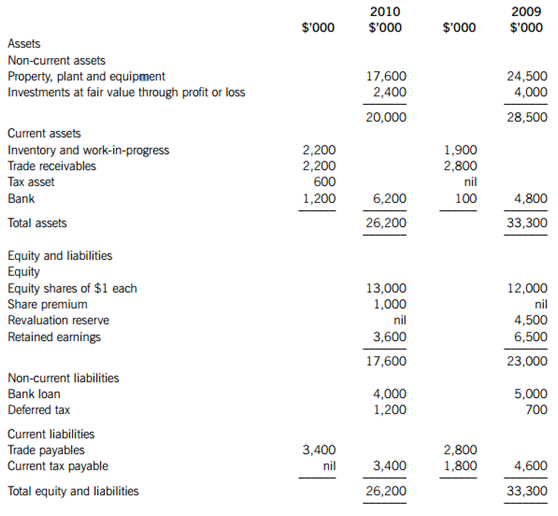
The following information has been obtained from the Chairman’s Statement and the notes to the fi nancial statements:
‘Market conditions during the year ended 30 September 2010 proved very challenging due largely to diffi culties in the global economy as a result of a sharp recession which has led to steep falls in share prices and property values. Hardy has not been immune from these effects and our properties have suffered impairment losses of $6 million in the year.’
The excess of these losses over previous surpluses has led to a charge to cost of sales of $1·5 million in addition to the normal depreciation charge.
‘Our portfolio of investments at fair value through profi t or loss has been ‘marked to market’ (fair valued) resulting in a loss of $1·6 million (included in administrative expenses).’
There were no additions to or disposals of non-current assets during the year
‘In response to the downturn the company has unfortunately had to make a number of employees redundant incurring severance costs of $1·3million (included in cost of sales) and undertaken cost savings in advertising and other administrative expenses.’
‘The diffi culty in the credit markets has meant that the fi nance cost of our variable rate bank loan has increased from 4·5% to 8%. In order to help cash fl ows, the company made a rights issue during the year and reduced the dividend per share by 50%.’
‘Despite the above events and associated costs, the Board believes the company’s underlying performance has been quite resilient in these diffi cult times.’
Required:
Analyse and discuss the fi nancial performance and position of Hardy as portrayed by the above fi nancial statements and the additional information provided.
Your analysis should be supported by profi tability, liquidity and gearing and other appropriate ratios (up to 10 marks available).
第5题
The following trial balance relates to Cavern as at 30 September 2010:
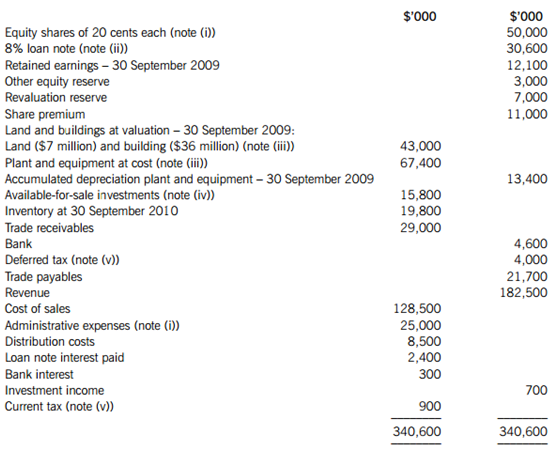
The following notes are relevant:
(i) Cavern has accounted for a fully subscribed rights issue of equity shares made on 1 April 2010 of one new share for every four in issue at 42 cents each. The company paid ordinary dividends of 3 cents per share on 30 November 2009 and 5 cents per share on 31 May 2010. The dividend payments are included in administrative expenses in the trial balance.
(ii) The 8% loan note was issued on 1 October 2008 at its nominal (face) value of $30 million. The loan note will be redeemed on 30 September 2012 at a premium which gives the loan note an effective fi nance cost of 10% per annum.
(iii) Non-current assets:
Cavern revalues its land and building at the end of each accounting year. At 30 September 2010 the relevant value to be incorporated into the fi nancial statements is $41·8 million. The building’s remaining life at the beginning of the current year (1 October 2009) was 18 years. Cavern does not make an annual transfer from the revaluation reserve to retained earnings in respect of the realisation of the revaluation surplus. Ignore deferred tax on the revaluation surplus.
Plant and equipment includes an item of plant bought for $10 million on 1 October 2009 that will have a 10-year life (using straight-line depreciation with no residual value). Production using this plant involves toxic chemicals which will cause decontamination costs to be incurred at the end of its life. The present value of these costs using a discount rate of 10% at 1 October 2009 was $4 million. Cavern has not provided any amount for this future decontamination cost. All other plant and equipment is depreciated at 12·5% per annum using the reducing balance method.
No depreciation has yet been charged on any non-current asset for the year ended 30 September 2010. All depreciation is charged to cost of sales.
(iv) The available-for-sale investments held at 30 September 2010 had a fair value of $13·5 million. There were no acquisitions or disposals of these investments during the year ended 30 September 2010.
(v) A provision for income tax for the year ended 30 September 2010 of $5·6 million is required. The balance on current tax represents the under/over provision of the tax liability for the year ended 30 September 2009. At 30 September 2010 the tax base of Cavern’s net assets was $15 million less than their carrying amounts. The movement on deferred tax should be taken to the income statement. The income tax rate of Cavern is 25%.
Required:
(a) Prepare the statement of comprehensive income for Cavern for the year ended 30 September 2010.
(b) Prepare the statement of changes in equity for Cavern for the year ended 30 September 2010.
(c) Prepare the statement of fi nancial position of Cavern as at 30 September 2010.
Notes to the fi nancial statements are not required.
The following mark allocation is provided as guidance for this question:
(a) 11 marks
(b) 5 marks
(c) 9 marks
第6题
tion consisted of two elements: a share exchange of three shares in Premier for every fi ve acquired shares in Sanford and the issue of a $100 6% loan note for every 500 shares acquired in Sanford. The share issue has not yet been recorded by Premier, but the issue of the loan notes has been recorded. At the date of acquisition shares in Premier had a market value of $5 each and the shares of Sanford had a stock market price of $3·50 each. Below are the summarised draft fi nancial statements of both companies.
Statements of comprehensive income for the year ended 30 September 2010
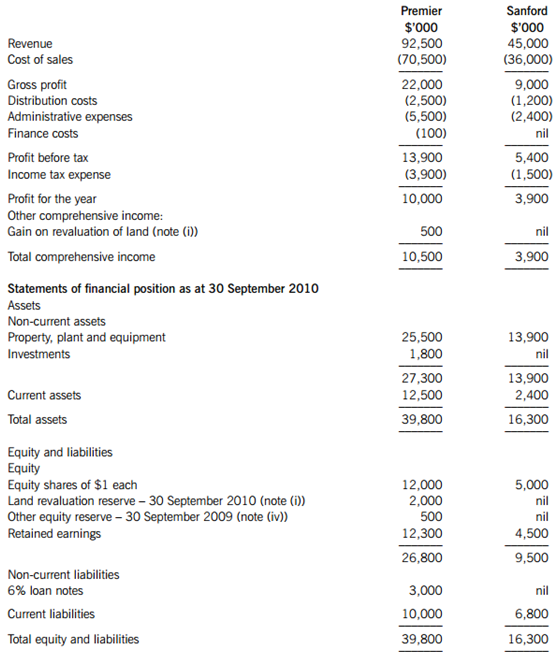
The following information is relevant:
(i) At the date of acquisition, the fair values of Sanford’s assets were equal to their carrying amounts with the exception of its property. This had a fair value of $1·2 million below its carrying amount. This would lead to a reduction of the depreciation charge (in cost of sales) of $50,000 in the post-acquisition period. Sanford has not incorporated this value change into its entity fi nancial statements.
Premier’s group policy is to revalue all properties to current value at each year end. On 30 September 2010, the value of Sanford’s property was unchanged from its value at acquisition, but the land element of Premier’s property had increased in value by $500,000 as shown in other comprehensive income.
(ii) Sales from Sanford to Premier throughout the year ended 30 September 2010 had consistently been $1 million per month. Sanford made a mark-up on cost of 25% on these sales. Premier had $2 million (at cost to Premier) of inventory that had been supplied in the post-acquisition period by Sanford as at 30 September 2010.
(iii) Premier had a trade payable balance owing to Sanford of $350,000 as at 30 September 2010. This agreed with the corresponding receivable in Sanford’s books.
(iv) Premier’s investments include some available-for-sale investments that have increased in value by $300,000 during the year. The other equity reserve relates to these investments and is based on their value as at 30 September 2009. There were no acquisitions or disposals of any of these investments during the year ended 30 September 2010.
(v) Premier’s policy is to value the non-controlling interest at fair value at the date of acquisition. For this purpose Sanford’s share price at that date can be deemed to be representative of the fair value of the shares held by the non-controlling interest.
(vi) There has been no impairment of consolidated goodwill.
Required:
(a) Prepare the consolidated statement of comprehensive income for Premier for the year ended 30 September 2010.
(b) Prepare the consolidated statement of fi nancial position for Premier as at 30 September 2010.
The following mark allocation is provided as guidance for this question:
(a) 9 marks
(b) 16 marks
第7题
ilding of a new store. The directors are aware that in accordance with IAS 23 Borrowing costs certain borrowing costs have to be capitalised.
Required:
Explain the circumstances when, and the amount at which, borrowing costs should be capitalised in accordance with IAS 23. (5 marks)
(b) Details relating to construction of Apex’s new store:
Apex issued a $10 million unsecured loan with a coupon (nominal) interest rate of 6% on 1 April 2009. The loan is redeemable at a premium which means the loan has an effective fi nance cost of 7?5% per annum. The loan was specifi cally issued to fi nance the building of the new store which meets the defi nition of a qualifying asset in IAS 23. Construction of the store commenced on 1 May 2009 and it was completed and ready for use on 28 February 2010, but did not open for trading until 1 April 2010. During the year trading at Apex’s other stores was below expectations so Apex suspended the construction of the new store for a two-month period during July and August 2009. The proceeds of the loan were temporarily invested for the month of April 2009 and earned interest of $40,000.
Required:
Calculate the net borrowing cost that should be capitalised as part of the cost of the new store and the fi nance cost that should be reported in the income statement for the year ended 31 March 2010. (5 marks)
第8题
e preparation and presentation of fi nancial statements is that transactions should be recorded on the basis of their substance over their form.
Required:
Explain why it is important that fi nancial statements should refl ect the substance of the underlying transactions and describe the features that may indicate that the substance of a transaction may be different from its legal form. (5 marks)
(b) Wardle’s activities include the production of maturing products which take a long time before they are ready to retail. Details of one such product are that on 1 April 2009 it had a cost of $5 million and a fair value of $7 million. The product would not be ready for retail sale until 31 March 2012.
On 1 April 2009 Wardle entered into an agreement to sell the product to Easyfi nance for $6 million. The agreement gave Wardle the right to repurchase the product at any time up to 31 March 2012 at a fi xed price of $7,986,000, at which date Wardle expected the product to retail for $10 million. The compound interest Wardle would have to pay on a three-year loan of $6 million would be:

This interest is equivalent to the return required by Easyfi nance.
Required:
Assuming the above fi gures prove to be accurate, prepare extracts from the income statement of Wardle for the three years to 31 March 2012 in respect of the above transaction:
(i) Refl ecting the legal form. of the transaction;
(ii) Refl ecting the substance of the transaction.
Note: statement of fi nancial position extracts are NOT required.
The following mark allocation is provided as guidance for this requirement:
(i) 2 marks
(ii) 3 marks (5 marks)
(c) Comment on the effect the two treatments have on the income statements and the statements of fi nancial position and how this may affect an assessment of Wardle’s performance. (5 marks)
第9题
(a) The following information relates to the draft fi nancial statements of Deltoid.
Summarised statements of fi nancial position as at:
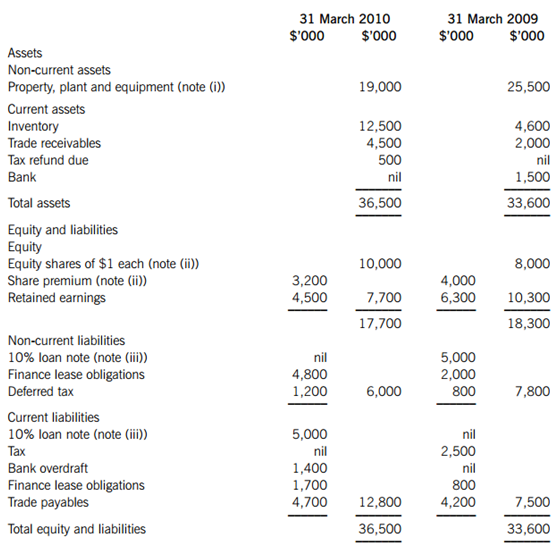
Summarised income statements for the years ended:
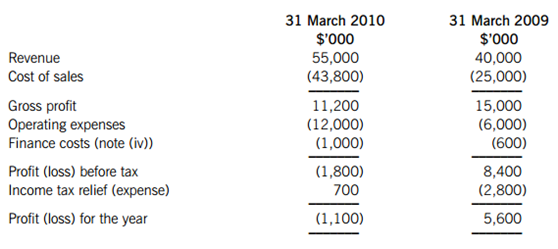
The following additional information is available:
(i) Property, plant and equipment is made up of:

(ii) On 1 July 2009 there was a bonus issue of shares from share premium of one new share for every 10 held.
On 1 October 2009 there was a fully subscribed cash issue of shares at par.
(iii) The 10% loan note is due for repayment on 30 June 2010. Deltoid is in negotiations with the loan provider to refi nance the same amount for another fi ve years.
(iv) The fi nance costs are made up of:
For year ended:

Required:
(i) Prepare a statement of cash fl ows for Deltoid for the year ended 31 March 2010 in accordance with IAS 7 Statement of cash fl ows, using the indirect method; (12 marks)
(ii) Based on the information available, advise the loan provider on the matters you would take into consideration when deciding whether to grant Deltoid a renewal of its maturing loan note. (8 marks)
(b) On a separate matter, you have been asked to advise on an application for a loan to build an extension to a sports club which is a not-for-profi t organisation. You have been provided with the audited fi nancial statements of the sports club for the last four years.
Required:
Identify and explain the ratios that you would calculate to assist in determining whether you would advise that the loan should be granted. (5 marks)
第10题
The following trial balance relates to Dune at 31 March 2010:
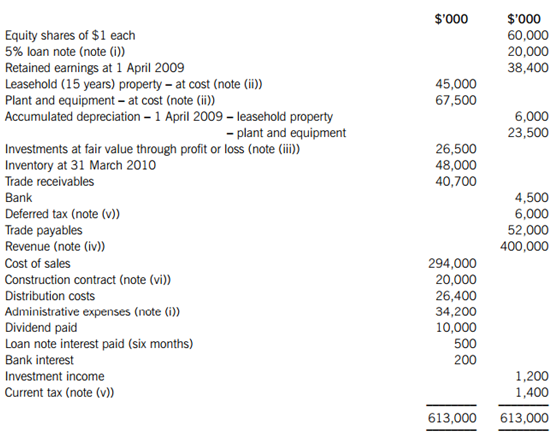
The following notes are relevant:
(i) The 5% loan note was issued on 1 April 2009 at its nominal (face) value of $20 million. The direct costs of the issue were $500,000 and these have been charged to administrative expenses. The loan note will be redeemed on 31 March 2012 at a substantial premium. The effective fi nance cost of the loan note is 10% per annum.
(ii) Non-current assets:
In order to fund a new project, on 1 October 2009 the company decided to sell its leasehold property. From that date it commenced a short-term rental of an equivalent property. The leasehold property is being marketed by a property agent at a price of $40 million, which was considered a reasonably achievable price at that date. The expected costs to sell have been agreed at $500,000. Recent market transactions suggest that actual selling prices achieved for this type of property in the current market conditions are 15% less than the value at which they are marketed. At 31 March 2010 the property had not been sold.
Plant and equipment is depreciated at 15% per annum using the reducing balance method.
No depreciation/amortisation has yet been charged on any non-current asset for the year ended 31 March 2010. Depreciation, amortisation and impairment charges are all charged to cost of sales.
(iii) The investments at fair value through profi t or loss had a fair value of $28 million on 31 March 2010. There were no purchases or disposals of any of these investments during the year.
(iv) It has been discovered that goods with a cost of $6 million, which had been correctly included in the count of the inventory at 31 March 2010, had been invoiced in April 2010 to customers at a gross profi t of 25% on sales, but included in the revenue (and receivables) of the year ended 31 March 2010.
(v) A provision for income tax for the year ended 31 March 2010 of $12 million is required. The balance on current tax represents the under/over provision of the tax liability for the year ended 31 March 2009. At 31 March 2010 the tax base of Dune’s net assets was $14 million less than their carrying amounts. The income tax rate of Dune is 30%.
(vi) The details of the construction contract are:

The contract commenced on 1 October 2009 and is scheduled to take 18 months to complete. The agreed contract price is fi xed at $40 million. Specialised plant was purchased at the start of the contract for $12 million. It is expected to have a residual value of $3 million at the end of the contract and should be depreciated using the straight-line method on a monthly basis. An independent surveyor has assessed that the contract is 30% complete at 31 March 2010. The customer has not been invoiced for any progress payments. The outcome of the contract is deemed to be reasonably certain as at the year end.
Required:
(a) Prepare the income statement for Dune for the year ended 31 March 2010.
(b) Prepare the statement of fi nancial position for Dune as at 31 March 2010.
Notes to the fi nancial statements are not required.
A statement of changes in equity is not required.
The following mark allocation is provided as guidance for this question:
(a) 13 marks
(b) 12 marks

 警告:系统检测到您的账号存在安全风险
警告:系统检测到您的账号存在安全风险
为了保护您的账号安全,请在“上学吧”公众号进行验证,点击“官网服务”-“账号验证”后输入验证码“”完成验证,验证成功后方可继续查看答案!
